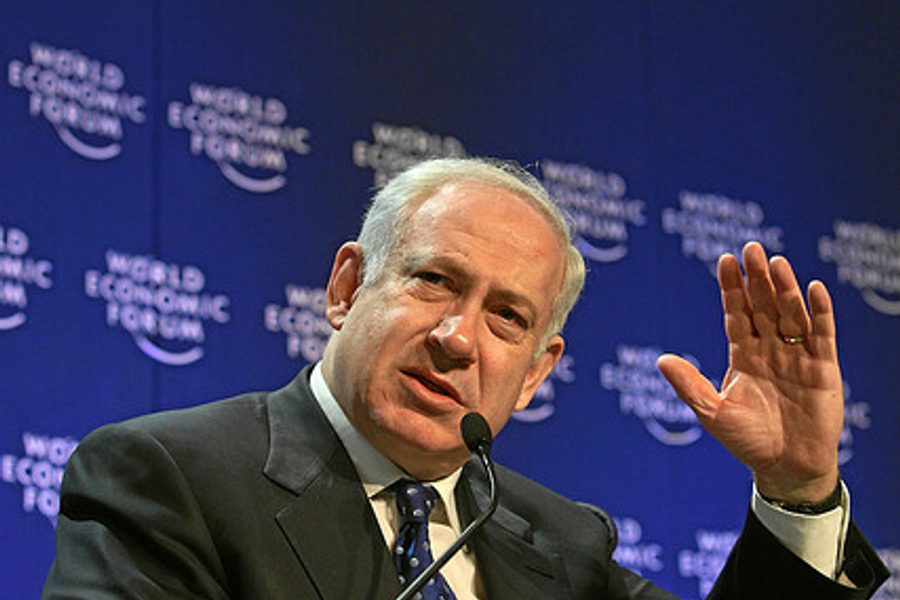Right-Wingers, Failed Leaders and Media Stars Jockey for Israeli Votes
A clash of parties is likely to yield a new coalition government, but not a new direction.
Ralph Seliger

Israel’s elections are scheduled for Tuesday, January 22, with Prime Minister Benjamin Netanyahu’s re-election considered certain, but the nature of his coalition still unknown.
Israel is plagued by an unwieldy form of proportional representation. There are no geographically divided districts; instead, parties submit lists of candidates to a nationwide pool, and voters pick their favorite list. This gives voters a wide range of party choices, but little ability to support particular candidates. Parties determine how their lists are ordered, and a candidate’s relative position determines his or her chances for election. This year’s election involves 34 competing lists, but only 12 or 13 have a realistic chance to garner at least 2 percent of the vote—the approximate threshold to make it into the Knesset (parliament).
The president chooses the party leader who heads the list with the most votes, or is considered most able to cobble together a majority coalition of 61 seats in the 120-seat Knesset. This leader has 42 days to assemble a functional majority; if that fails, another leader is given the opportunity (as in 2009, when Tzipi Livni’s Kadima party won the most votes, but Netanyahu succeeded where she failed in pulling together a majority to become prime minister).
Sometimes two or more parties agree to run a common list, which may or may not lead to a full merger down the road. Much buzz followed Netanyahu’s decision in late October to merge his right-wing Likud party’s list with that of his nationalist coalition partner, the “Israel Our Home” party of Foreign Minister Avigdor Lieberman. (Lieberman resigned as foreign minister due to an indictment for “breach of trust and fraud” over a bribery scandal surrounding an ambassadorship—but the law is so toothless that he is expected to continue to serve in parliament unless convicted.) Even before creating the joint list, Likud had lurched further right in its primary when a number of relative moderates were defeated. As a result, a majority of Likud candidates openly oppose a two-state solution with the Palestinians, a position that contradicts the stated goals of both Netanyahu and Lieberman.
Paradoxically, recent polls show that most Israelis, even a majority of right-wing voters, support a two-state solution. Yet hopes for such a resolution are low; most Israelis were convinced by the suicide bombers of the Second Intifada and the frequent attacks from Gaza following Israel’s 2005 withdrawal that they have no credible partner for peace, even as they blindly tolerate settlement expansion in East Jerusalem and the West Bank and bullying tactics that engender Palestinian enmity. (In other words, the bad behavior of one side inspires new provocations from the other in turn.)
Suddenly, this new joint list is being threatened on the right by the “Jewish Home” party, itself an amalgam of the old National Religious Party and some far-right allies. Jewish Home is led by Naftali Bennett, an attractive young entrepreneur whose party is avidly pro-settler and explicitly opposes a Palestinian state. Polls show the party steadily gaining votes from Netanyahu, although not enough to seriously challenge his national leadership. Jewish Home is more likely in the running for second place along with the Labor Party, Israel’s traditional but recently fallen party of the center-Left.
Labor is making a comeback, with its new leader, Shelly Yachimovich, a former print and broadcast journalist, projecting a fresh face on a party literally rent apart by its previous leader and failed heir to the legacy of Yitzhak Rabin, Ehud Barak who briefly served as prime minister before a much longer stint as defense minister. With his electoral chances polling dismally in late November, Barak announced his retirement from politics, taking his less-than-two-year-old Independence party (a semi-hawkish split-off from Labor) down with him.
However, Yachimovich’s fortunes are rising based only on her stance on Israeli economic and social-justice issues, with the barest whisper of a view on Palestine that is more dovish than Netanyahu’s. (She has been largely silent on the situation, but did state her support for the “Clinton Parameters” of Dec. 2000, in which Bill Clinton indicated that Jerusalem and the West Bank should be divided roughly according to where Israelis and Palestinians are concentrated.) Labor’s renewed socioeconomic focus is underscored by the prominent positioning on the party list of two young leaders of the Israeli version of Occupy, a massive social protest movement that took to the streets in 2011.
A second comeback story, wrapped up in the person of another failed politician, is the return of Tzipi Livni, whose Kadima party won more votes than Likud in 2009 but could not secure a majority coalition. Considered a weak opposition leader, she lost the chairmanship of Kadima by a 2 to 1 primary vote last March. But her successor destroyed this party’s credibility by entering Netanyahu’s coalition after pledging not to, only to abruptly leave less than ten weeks later. Kadima may not even make the cut to enter the Knesset.
Livni suddenly rejoined the political fray at the head of a new party called “The Movement,” prompting a stampede of Kadima parliamentarians to her side. Livni is considered the only mainstream political leader to offer a serious vision of a negotiated peace with the Palestinians. And with two former leaders of Labor joining as numbers three and four on her list — one of whom headed the Histadrut trade-union federation in the 1990s — she begins to offer the semblance of an appeal for economic justice as well.
Livni’s entry has cut into a modest resurgence by Meretz, a party which had been unique in campaigning on the whole progressive package of peace, human rights and social democracy. Its slogans explicitly call upon leftists to return to “Meretz, the Left of Israel.”
Also on the left is Hadash, a party with Communist roots that draws 85 percent of its support from Israeli Arabs. With Meretz relying, in parallel, on an overwhelmingly Israeli Jewish constituency, the two parties have agreed not to campaign against each other. Two other parties, the United Arab List and Balad, traditionally appeal only to Arab voters. Together, these four parties, very loosely defined as the Left, are likely to garner only about 15 of the 120 seats.
Yet another contender is the brand-new, centrist “There’s a Future” party, led by a political novice, a photogenic television showman named Yair Lapid, who seems peculiarly devoid of significant ideas other than claiming to be a moderate. Lapid, Yachimovich and Livni have conferred on a joint strategy to counter the Right, but too late to combine into a single list and without arriving at an agreement.
This profusion of newcomers, latecomers and retreads has left most of the Israeli electorate confused. With 20 percent polling as undecided, January 22 could bring some surprises. But the most likely outcome is that Netanyahu retains control, with the political makeup of the next government determined by which parties Netanyahu invites to a new coalition, and who accepts. My guess is that Netanyahu would prefer taking in parties of the center and center-left rather than the Jewish Home, so that he’s not tethered to the extreme Right. Regardless, the extreme conservatism of Netanyahu’s own list promises a new government of stagnation, in which Israel continues to slide toward an oppressive one-state future, which most Israelis claim not to support, and Palestinians ultimately will not accept.








